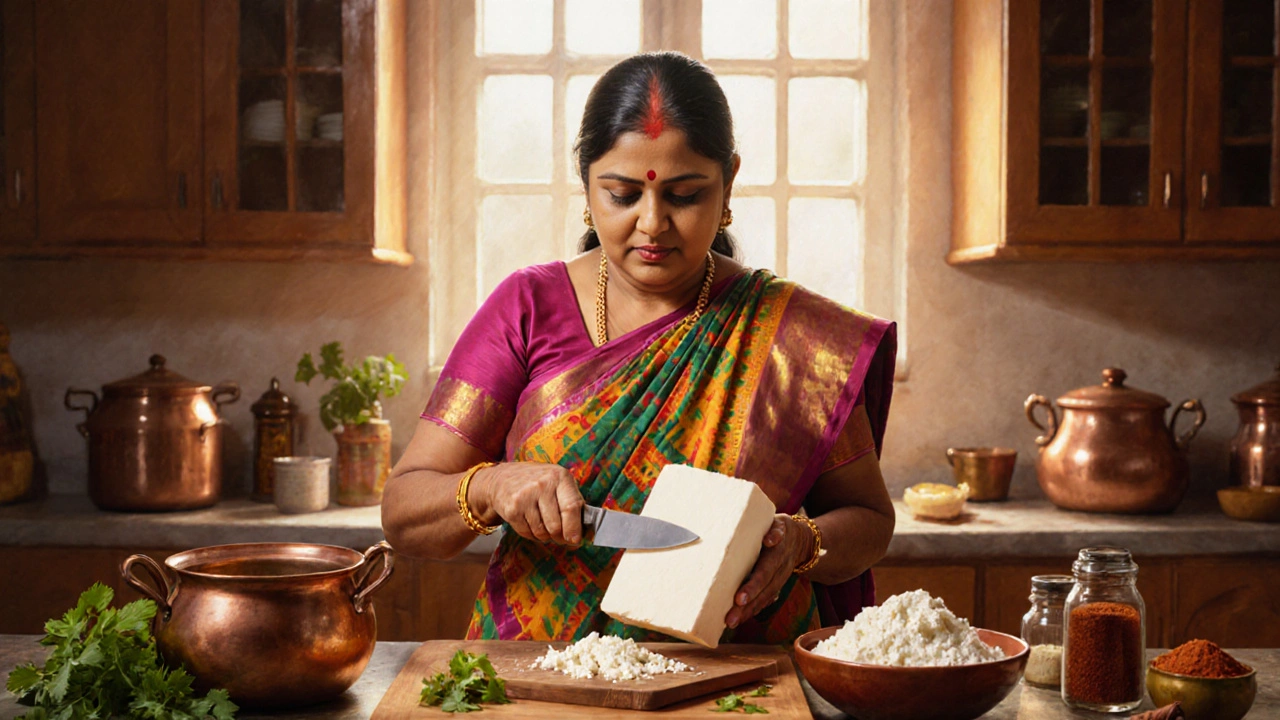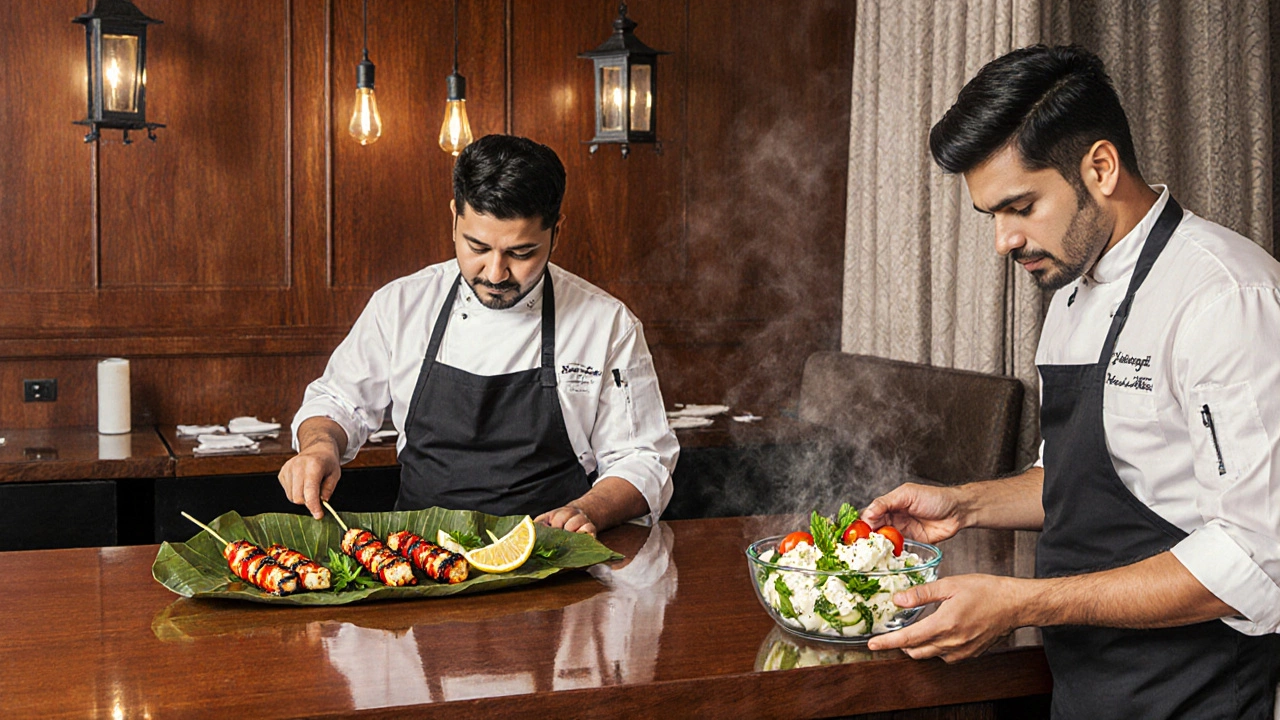Paneer English Name: What to Call Indian Cottage Cheese

Paneer Terminology Selector
Select your target audience or context to get the recommended English term for paneer:
Target Audience or Context
Ever stared at a menu and wondered whether to write ‘paneer’ or ‘cottage cheese’ on an English‑language recipe card? You’re not alone. The Indian dairy block known as paneer carries several English equivalents, and picking the right one depends on context, audience, and culinary nuance.
paneer English name
- Paneer is often called “Indian cottage cheese”.
- In many Western cookbooks you’ll see it listed simply as “cottage cheese”.
- For food‑label compliance in the UK and US, the term “fresh cheese” is acceptable.
What is paneer?
Paneer is a fresh, non‑melting cheese made by curdling hot milk with an acidic agent such as lemon juice, vinegar, or citric acid. It has a mild, milky flavor and a firm, crumbly texture that holds up well in curries, grilled skewers, and salads. Because it’s not aged or salted, paneer retains almost the same nutritional profile as the milk it started from - high in calcium, protein, and casein.
Direct English equivalents
When you need an English label, three terms surface most often:
- Cottage cheese - a soft, curdled cheese common in the West, usually sold with a creamy liquid. While its texture is looser than paneer, many people use the names interchangeably for convenience.
- Fresh cheese - a generic descriptor for any cheese that hasn’t been aged or pressed, covering paneer, queso fresco, and even ricotta.
- Indian cottage cheese - a hybrid term that keeps the cultural cue while making the meaning clear to English speakers.
How paneer is made - the process in plain English
The preparation steps are simple enough to explain without culinary jargon:
- Heat whole milk to just below boiling (around 90‑95°C).
- Add an acid (lemon juice, white vinegar, or citric acid) while stirring gently.
- Observe the milk separate into curds (solid) and whey (liquid).
- Let the curds sit for a minute, then strain through a cheesecloth.
- Press the wrapped curds with a heavy object for 15‑30minutes to shape a firm block.
The result is a dense, white block that can be cut into cubes, sliced, or grated.

When to use “paneer” versus an English term
Choosing the right label isn’t just about translation; it’s about audience expectations:
- Recipe blogs targeting home cooks: Keep “paneer” if you’re writing for a globally aware audience. Readers often search “paneer curry” and expect the authentic ingredient.
- Food‑service menus in the UK or US: Use “cottage cheese” or “Indian cottage cheese” to avoid confusing diners who have never heard the Hindi word.
- Packaging for export: Follow local labeling regulations - “fresh cheese” is a safe, legally accepted term in most jurisdictions.
Common misconceptions
Many people equate paneer with tofu, ricotta, or even mozzarella. Here’s why those shortcuts can bite you:
- Tofu is soy‑based, grainy, and takes on flavors differently. Substituting tofu for paneer changes the protein source and texture dramatically.
- Ricotta is soft, creamy, and high in moisture. It melts easily, unlike paneer’s firm bite.
- Mozzarella stretches when heated; paneer never does. Swapping them in a dish like Palak Paneer will leave you with a watery sauce.
Quick translation guide
| Hindi term | Common English name | When to use |
|---|---|---|
| Paneer | Indian cottage cheese | Authenic Indian recipes, cultural context |
| Paneer | Cottage cheese | Western recipe blogs, casual home cooking |
| Paneer | Fresh cheese | Food‑labeling, export markets |
Regional variations and other languages
Across South Asia, paneer appears under different names. In Bangladesh it’s still called “paneer,” while in Pakistan you’ll see “panir.” In Marathi, the term stays the same but local recipes might add chaat masala for a tangy twist. Knowing these variations helps when translating regional cookbooks.

Frequently Asked Questions
Is paneer the same as cottage cheese?
They share a similar curdling process, but paneer is firmer, drier, and doesn’t contain the creamy whey that commercial cottage cheese usually has. For most recipes, you can call paneer “cottage cheese,” but the texture will differ.
Can I use store‑bought cottage cheese instead of paneer?
For a quick shortcut, yes, but press the cottage cheese in a cheesecloth to remove excess liquid and firm it up. The result won’t be as dense, and the flavor will be slightly milder.
Why does paneer not melt like mozzarella?
Paneer’s protein structure is set by acid coagulation, not bacterial fermentation. The curd bonds are tight, so heat can’t break them down the way it does with mozzarella’s stretch‑making cultures.
Is “fresh cheese” a legal term on UK food labels?
Yes. UK food‑labelling regulations allow “fresh cheese” to describe any cheese that has not undergone ripening, which includes paneer. Just ensure the ingredient list also mentions the source, e.g., “made from milk”.
How does paneer fit into a vegetarian protein plan?
A 100‑gram block of paneer delivers roughly 18grams of high‑quality protein, making it a staple for vegetarians who need a reliable protein source without relying on legumes.